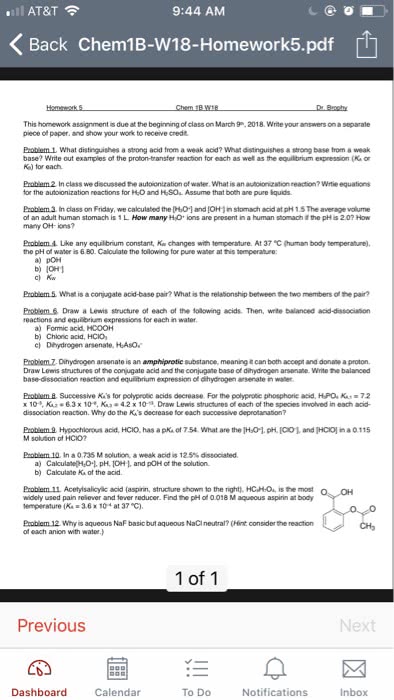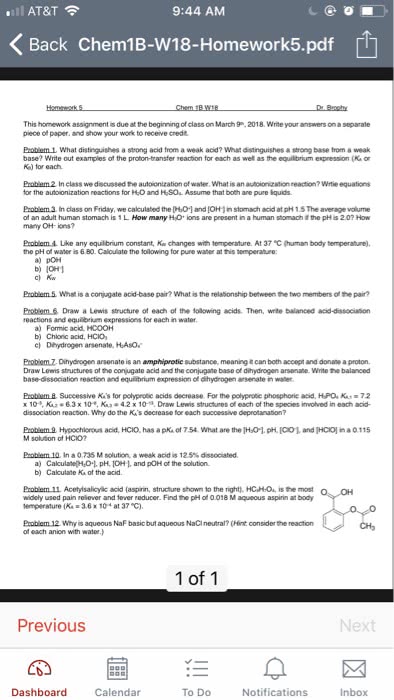AS.030.205 Chapter Notes - Chapter 2: Buffer Solution, Boron, Electronegativity

Chapter 2: Acids and Bases: Central to Understanding Organic
Chemistry
2.1: An Introduction to Acids and Bases
Acid (Brønsted – Lowry): a species that loses a proton
Base (Brønsted – Lowry): a species that gains a proton
Acid-base reaction (proton transfer reaction): reaction of acid with base (the
reverse reaction is called the same thing)
*According to Brønsted – Lowry definitions, any species that has a hydrogen can
potentially act as an acid, and any species that has a lone pair can potentially
act as a base
*both an acid and a base must be present in an acid-base reaction b/c an acid cannot
lose a proton unless a base is present to accept it
Reversible/Irreversible Reactions:
*most acid-base reactions are reversible
Conjugate base: the resulting species when an acid loses a proton
Conjugate acid: the resulting species when a base gains a proton
find more resources at oneclass.com
find more resources at oneclass.com

Acidity: measure of the tendency of a compound to lose a proton
Basicity: measure of a compound’s affinity for a proton
Strong acid/base: strong tendency/high affinity to lose/for a proton
Weak acid/base: little tendency/low affinity to lose/for a proton
*the stronger the acid, the weaker its conjugate base, and the stronger the base, the
weaker its conjugate acid
*HBr is a stronger acid than HCl, so Br- is a weaker base than Cl-
2.2: pKa and pH
*when a strong acid is dissolved in water, almost all the molecules dissociate, so
products are favored at equilibrium (equilibrium lies to the right)
*when a much weaker acid is dissolved in water, very few molecules dissociate, so
reactants are favored at equilibrium (equilibrium lies to the left)
*longer arrow is drawn towards the species favored at equilibrium
Keq (equilibrium constant): degree to which an acid (HA) dissociates in an aqueous
solution
Ka (acid dissociation constant): degree to which an acid (HA) dissociates
pKa: indicator of acid strength (larger Ka = stronger acid, smaller pKa = stronger
acid)
find more resources at oneclass.com
find more resources at oneclass.com

pH: indicator of concentration of protons in a solution
*do NOT confuse pH and pKa: pH describes acidity of a solution, pKa
indicates tendency of a compound to lose its proton (pKa is a
characteristic)
2.3: Organic Acids and Bases
Carboxylic acids: compounds that have a COOH group
*pKa values range from about 3 to 5 (weak acids)
Alcohols: compounds that have an OH group
* pKa values close to 16 (much weaker acids than carboxylic acids)
Amines: compounds that result from replacing one or more of the hydrogens
bonded to ammonia with a carbon-containing substituent
*amines and ammonia have such high pKa values that they rarely behave as acids –
they are more likely to act as bases (they the most common organic bases)
Protonated Compounds: compounds that gained an additional proton
*based on their pKa values, protonated methylamine is a stronger acid than
protonated ethylamine, which means that methylamine is a weaker base
than ethylamine
find more resources at oneclass.com
find more resources at oneclass.com
Document Summary
Chapter 2: acids and bases: central to understanding organic. Acid (br nsted lowry): a species that loses a proton. Base (br nsted lowry): a species that gains a proton. Acid-base reaction (proton transfer reaction): reaction of acid with base (the reverse reaction is called the same thing) *according to br nsted lowry definitions, any species that has a hydrogen can potentially act as an acid, and any species that has a lone pair can potentially act as a base. *both an acid and a base must be present in an acid-base reaction b/c an acid cannot lose a proton unless a base is present to accept it. Conjugate base: the resulting species when an acid loses a proton. Conjugate acid: the resulting species when a base gains a proton. Acidity: measure of the tendency of a compound to lose a proton. Basicity: measure of a compound"s affinity for a proton. Strong acid/base: strong tendency/high affinity to lose/for a proton.



